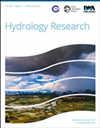埃塞俄比亚Wabi Shebele河流域土地利用和土地覆盖变化及其对洪水灾害发生的影响
IF 2.4
4区 环境科学与生态学
Q2 Environmental Science
引用次数: 0
摘要
土地利用和土地覆盖(LULC)的变化会影响水文条件,如地表系数、径流和渗透。本研究使用土壤和水评估工具(SWAT)和分离方法调查了LULC的变化及其对Wabi Shebele流域水资源的影响。西北部的地表和地下水参数;盆地东部高地和南部低地的土壤和地表参数被确定为产水的敏感参数。从20世纪80年代到2010年,农田覆盖率增加了48.63%,而森林和林地覆盖率分别下降了49.14%和14.76%。在此期间模拟的径流表明,这些流域的流量增加,显示出农田显著增加,森林覆盖率下降,尤其是在Dodola、Maribo、Robe和Erer流域的Wabi。根据不同LULC地图下的模拟日径流计算的洪水指数(即AMAX、SMW、SMSp和SMSu)表明,中部和西北部流域的洪水指数分别增加了1.83%和0.44%。LULC变化对洪水流量的影响程度与气候变化对洪水危害的影响程度相当,尤其是在流域中部。本文章由计算机程序翻译,如有差异,请以英文原文为准。
Land-use and land-cover change and its impact on flood hazard occurrence in Wabi Shebele River Basin of Ethiopia
Land-use and land-cover (LULC) changes can impact hydrological conditions such as land surface coefficient, runoff, and infiltration. This study investigates the changes in LULC and its impact on water resources of the Wabi Shebele basin using the soil and water assessment tool (SWAT) and a separation method. Surface and groundwater parameters in the northwestern; and soil and surface parameters in the eastern highland and southern lowland parts of the basin are identified as sensitive parameters in water production. The coverage of cropland was increased by 48.63% while forest and woodland decreased by 49.14 and 14.76%, respectively, between the 1980s and 2010. Streamflow simulated during this period indicates increases in those watersheds showing significant cropland increases and forest coverage decreases particularly in Wabi at Dodola, Maribo, Robe, and Erer watersheds. Flood indices (i.e., AMAX, SMW, SMSp, and SMSu) calculated from simulated daily streamflow under different LULC map indicates an increase in the middle and northwestern watersheds up to 1.83 and 0.44%, respectively. The impact level of LULC change on flood discharge shows a comparable level with climate change impact on flood hazard particularly in the middle part of the basin.
求助全文
通过发布文献求助,成功后即可免费获取论文全文。
去求助
来源期刊

Hydrology Research
Environmental Science-Water Science and Technology
CiteScore
5.30
自引率
7.40%
发文量
70
审稿时长
17 weeks
期刊介绍:
Hydrology Research provides international coverage on all aspects of hydrology in its widest sense, and welcomes the submission of papers from across the subject. While emphasis is placed on studies of the hydrological cycle, the Journal also covers the physics and chemistry of water. Hydrology Research is intended to be a link between basic hydrological research and the practical application of scientific results within the broad field of water management.
 求助内容:
求助内容: 应助结果提醒方式:
应助结果提醒方式:


